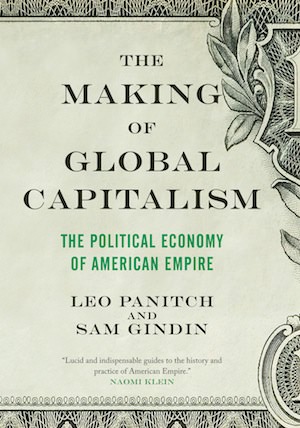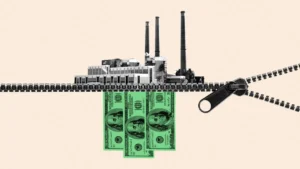The Making of Global Capitalism
Although Karl Marx discerned in the middle of the 19th century that a new class of capitalists was creating "a world after its own image," it took until the beginning of the 21st century before "a constantly expanding market" could be said to have fully spread capitalist social relations "over the entire surface of the globe," write Leo Panitch and Sam Gindin in their new book, "The Making of Global Capitalism."
The following is the conclusion to Leo Panitch and Sam Gindin’s new book, “The Making of Global Capitalism: The Political Economy of American Empire” (Verso Books, 2012). It is used with permission and protected by copyright.
Read a review of the book, “a masterful century-long history of US corporate activity and state economic strategy,” by Patrick Bond at Red Pepper.
Although Marx discerned in the middle of the 19th century that a new class of capitalists was creating ‘a world after its own image’, it actually took until the beginning of the 21st century before ‘a constantly expanding market’ could be said to have fully spread capitalist social relations ‘over the entire surface of the globe’. Moreover, it was not a generic ‘bourgeoisie’ driven by competition to ‘nestle everywhere, settle everywhere, establish connections everywhere’ that alone made global capitalism after its own image. It took an empire of a new kind, founded on US capitalism’s great economic strength and centred on the capacities of the American state, to make global capitalism a reality. Yet no sooner did the task look to be more or less complete when the fourth great crisis of global capitalism (after those of the 1870s, the 1930s and the 1970s) spread rapidly across the world. Marx’s observation 150 years earlier, that the making of capitalism on a global scale was ‘paving the way for more extensive and more destructive crises’ while at the same time ‘diminishing the means whereby crises are prevented’, seemed all too fully confirmed. And it was now the American empire that seemed to resemble ‘the sorcerer who is no longer able to control the powers of the nether world whom he has called up by his spells’.
Given the severity and duration of the latest crisis in a global capitalist economy that the American state had been so central to constructing, it was hardly surprising to see a resurgence of pronouncements that US hegemony was coming to an end. As pundits of every persuasion once again blur the lines between a capitalist crisis and the decline of the US empire, it is especially important to recognize the central role which the American state continues to play in reproducing global capitalism. To be sure, the current crisis has amply demonstrated the many challenges and contradictions it faces in doing this, but it has also demonstrated that while the American empire is certainly not always able to control the spirits it has called up from the deep, it nevertheless remains critical to the system’s survival.
The Making of Global Capitalism: The Political Economy of American Empire
By Leo Panitch and Sam Gindin
Verso, 464 pages
The new crisis has confirmed more generally the continuing significance of states in global capitalism. Although the institutions of the European Union have more constitutional authority than other international organizations, their inability to intervene so as to resolve the debt crisis of their smaller member states is largely due to the internal political dynamics within other member states, above all Germany. The eurozone crisis also confirms a basic fact about the nature of both globalization and informal empire: state sovereignty is not effaced within it. This can be seen in the difficulties the American state has continually had to confront in getting the German state, from the time of the Herstaat banking crisis in the 1970s to the Mexican crisis in the 1990s to the crisis of the Euro today, to overcome its obsession with inflation and ‘moral hazard’ and to take its share of responsibility for containing crises. Yet this cannot be understood in terms of states, least of all Germany, retreating from free trade and free capital flows in favour of economic nationalism. After decades of economic integration, there are no national bourgeoisies like those that supported the fascist turn in Germany or Italy in the interwar period.
When the term ‘empire’ was openly embraced to characterize the American state at the time of the Bush administration’s response to 9/11 (including by some of its advisors), the stress was placed, in Niall Ferguson’s words, on the ‘potential advantages of a self-conscious American imperialism’ as against ‘the grave perils of being an “empire in denial”’. The anxieties of a Kansas farmer that ‘we are trying to run the world too much… like the Romans used to’ were taken as exemplifying not just the difficulties of mediating the American state’s international and domestic roles, but the loss of imperial vigour and discipline, the main measure of which, allegedly, was that the bill for Social Security in the US was larger than the bill for national security. Notably, it was not a new world of rival imperial states that occupied the minds of such analysts of US empire. The eyes cast askance at Germany and France over the tensions which the invasion of Iraq initially produced were largely overcome once these states introduced the motion at the UN to have it endorse the occupation a year later; while the US integration with China was such that Ferguson himself dubbed it ‘Chimerica’. With the typically absurd hyperbole that was so common in the years after 9/11, he rather claimed it was now only ‘non-state actors’ like criminal organizations and terrorist cells ‘who truly wield global power’.
The real problems of the US empire today appear in a very different light. As the global economic crisis triggered by the American financial crisis of 2007-8 persists, these problems have more to do with the difficulties of implementing adequate measures for ‘failure containment’, let alone ‘failure prevention’. Yet unlike the 1930s this has not been due to a breakdown of cooperation among capitalist states. As the G20 Toronto Summit communiqué of June 2010 proclaimed: ‘While the global economic crisis led to the sharpest decline of trade in more than seventy years, G20 countries chose to keep markets open to the opportunities that trade and investment offer. It was the right choice.’ The leaders renewed their ‘commitment to refrain from raising barriers or imposing new barriers to investment or trade in goods and services… [and] minimize any negative impact on trade and investment of our domestic policy actions, including fiscal policy and action to support the financial sector.’
But capitalist solidarity itself could not resolve the crisis of a finance-led global economy, where the orthodoxy of insisting on austerity – both to ensure that states pay their bond holders and to maintain vigilance against inflation – reinforces the stagnationist tendencies of under-consumption that comes with the diminished consumer credit available to sustain effective demand. The liberalization and expansion of finance, as this book has shown, was essential to the making of global capitalism, yet it came with a degree of volatility that threatened economic stability. Reviving capitalist health today requires strengthening the confidence of bankers that their activities will be appreciated and their assets protected. The unresolved dilemma for all capitalist states today is how to both stimulate the economy and regulate financial markets so as to limit increasingly dangerous volatility without undermining the ability of finance to play its essential role in capitalism. For most states, any attempt at fiscal stimulus aggravates the fears of bond holders that they won’t be repaid, and the increased rate of interest on the bonds necessary to fund fiscal and trade deficits requires restructuring state expenditure to prioritize interest payments over social expenditures, infrastructure development and public employment – thereby negating the very attempt at stimulus. This is the less the case for the US itself due to the ‘safe haven’ Treasury bonds represent, the appreciation of which is inseparable from the role of the American state as the ultimate guarantor of global capitalist interests. But the US faces its own policy dilemmas in terms of economic stimulus. The one immediate measure the US administration could take on its own to quickly revive effective demand, instructing the US housing agencies it directly controls to write off mortgage debt above the current value of existing homes, has been ruled out because it would reduce the banks’ mandated capital adequacy just as they are being required to raise it, and lower their revenues as homeowners made smaller monthly payments. This once again reveals the structural relationship between Wall Street and Washington: what makes such a move impossible is not that the votes in Congress are not there, but that it would threaten the solvency of some of the very large banks who are more than ever ‘too big to fail’ because their failure would trigger the failures of other financial institutions, not only in the US but around the world.
To be sure, the conflict between Congress and the administration, reflecting the internal contradiction which the American state faces between acting as both the state of the United States, and as the ‘indispensable’ state of global capitalism, has certainly worried leading capitalists and officials. The CEO of Caterpillar, the world’s largest manufacturer of construction and mining equipment, called Washington’s debt ceiling saga in the summer of 2011 not only ‘ugly’ but also ‘a red herring’ which got in the way of Congress’s ratification of outstanding free trade agreements, as well as much-needed domestic infrastructure programs. The Fed’s Ben Bernanke, noting that Congress had ‘disrupted financial markets’, warned that ‘similar events in the future could, over time, seriously jeopardize the willingness of investors around the world to hold U.S. financial assets or to make direct investments in job-creating U.S. businesses.’ Yet although it was precisely on these grounds that the credit rating agency Standard & Poor’s downgraded US Treasury bonds, what was especially remarkable was that the appetite for these bonds, even at record low interest rates, far from abating, increased. Ruminations about an alternative reserve currency went nowhere, especially as the smouldering crisis in Europe’s interbank markets burst into flames, sending the widespread earlier expectations that the Euro would challenge the dollar up in smoke.
The Making of Global Capitalism: The Political Economy of American Empire
By Leo Panitch and Sam Gindin
Verso, 464 pages
Much like Germany in the crisis of the 1970s, even China today explicitly speaks in terms of the US’s unique responsibilities for ‘the world’s economic soundness’ given its status as ‘the world’s largest economy and the issuer of the dominant international reserve currency’. American political leaders were reminded that ‘political brinkmanship in Washington is dangerously irresponsible… It risks, among other consequences, strangling the still fragile economic recovery of not only the United States but also the world as a whole.’ Similarly, the concerns of capitalists in developing capitalist states were that the US might now abandon them. The extent to which they continued to look to the American state to help them restructure their own states was seen when Obama visited India in November 2010, accompanied by the largest ever entourage of US businessmen on such a trip, and told an assembly of Mumbai capitalists: ‘We don’t simply welcome your rise, we ardently support it. We want to invest in it.’ The importance of this to Indian capitalists was made very clear by the co-founder of India’s National Association of Software and Service Companies, who recalled that the US ‘was the one who said to us… “Go for free trade and open markets.”’ This was crucial to his industry’s success in ‘pushing our government to open our markets for American imports, 100 percent foreign ownership of companies and tough copyright laws when it wasn’t fashionable.’ Stressing the continuing importance of the US in overcoming ‘the socialist/protectionists among India’s bureaucrats’, he emphasized that ‘We don’t want America to lose self-confidence… there is nobody else to take that leadership. Do we want China as the world’s moral leader? No. We desperately want America to succeed.’
There were deep structural factors at work here, reflecting not only the extensive networks that link the world’s capitalists to US MNCs, but to US financial, legal and business services more generally. The enormous demand for US Treasury bonds showed the extent to which the world remained on the dollar standard and the American state continued to be regarded as the main underwriter of value. The US Treasury and Fed’s central role in global crisis management – from currency swaps to provide other states with much needed dollars, to overseeing policy cooperation among the G20 as well as G7 central banks and finance ministries – was also confirmed. It was the formerly highly-touted supranational system of European governance – exposed in the crisis for its lack of central authority over taxation, bond issuance and budget approval – which now appeared most dysfunctional for the management of global capitalism.
The eurozone crisis was not something that cheered the American state. The Fed’s provision of liquidity to US financial institutions was undertaken with one eye to their passing that liquidity to Europe through the interbank market. The Treasury was intimately involved in policy discussions, directly as well as through the IMF, with Geithner ‘pressing Europe to take more decisive action’ at the regular conference calls of the G7 finance ministers now taking place almost weekly. It was a sign of ‘the growing concern in Washington at Europe’s handling of its debt crisis’ by the fall of 2011 that Geithner flew over to attend meetings of European finance ministers. Particularly frustrating was the limited extent to which the European Central Bank was prepared to act as lender of last resort. But behind this lay a frustration with the European states themselves. At a meeting in Washington an ECB official was greeted by his American host who ‘brandished the Articles of Confederation, the 1781 precursor to the United States Constitution, to use as an example of why stronger unions become necessary’.It was clear by this time that all the heady talk between Russia, China and other emerging market states about using ‘SDRs’ (the IMF’s ‘special drawing rights’), let alone the Euro, to displace the dollar as the international reserve currency had amounted to little more than rhetoric. Rumours that the Middle East’s oil exporting states would abandon the dollar vanished with the 2011 ‘Arab spring’, just as May ’68 put a stop to expectations that France might lead a return to the gold standard. The dollar’s continuing central global role certainly produced problems for rapidly growing emerging market economies, which experienced high capital inflows and currency appreciation as a result of the Fed’s low interest rates and quantitative easing policies. This stoked real estate and stock market bubbles in these countries, and threatened to undermine their competitiveness and bring back hyper-inflation. But criticisms such as those repeatedly heard in 2011 from Brazil, that US policy might lead to ‘currency wars’, amounted to nothing like a challenge to US hegemony.
The notion that the G20 would effectively become the linchpin of crisis management and policy coordination appeared mere window dressing by the time of the Cannes summit in the fall of 2011, with the BRIC countries left to insist that whatever financial contributions they might make to the European bailout would be channelled through an IMF still dominated by the G7 and especially the US Treasury. The most significant change from the pattern of crisis management in the 1980s and 1990s was that whereas it had earlier been the developing states that were required to practise austerity, the prescription for a capitalist cure for this structural crisis was reversed: the G7 states now committed themselves to austerity, while encouraging the emerging market states to stimulate their economies. This reflected the fact that the major developing states were now so much more an integral part of global capitalism, so the issue was no longer just to restructure them so as to facilitate free trade but also to make them more responsible for sustaining global demand. Yet the rising purchasing power of the developing countries could hardly make up for stagnation in the developed ones (US consumption expenditure alone remained some five times that of China and India combined).
The real issue was less about changing consumption patterns than whether any other state would be capable of playing the crucial role in the reproduction of global capitalism played by the American state. Claims that this would be a European supra-state now looked threadbare indeed. And amidst all the talk about the impending dominance of China, the crucial question rarely posed was whether the Chinese state had the capacity to take on extensive responsibilities for managing global capitalism. No one seriously imagines Russia, even with its admission to the WTO, could readily develop such capacity, but even China is manifestly still a very long way off from being able to do so. To this point, far from displacing the American empire, China rather seems to be duplicating Japan’s supplemental role in terms of providing the steady inflow of funds needed to sustain the US’s primary place in global capitalism.
The Making of Global Capitalism: The Political Economy of American Empire
By Leo Panitch and Sam Gindin
Verso, 464 pages
Were this to change, it would require deeper and much more liberalized financial markets within China, which would entail dismantling the capital controls that are key pillars of Communist Party rule – at a time, moreover, when its own banking system is under severe stress. Furthermore, a major reorientation of Chinese patterns of investment and production away from exports towards domestic consumption would have incalculable implications for the social relations that have sustained China’s rapid growth and global integration. It would involve a restructuring of the country’s coastal industries, which would come up against powerful vested interests among Chinese capitalists and regional officials. And getting households to spend their savings on current consumption would also involve developing a welfare state as well as ongoing increases in wages. Given the redistribution of income that this would entail, which could only happen through a substantial shift of power to the working class, all of this – while certainly possible in the long run – would meet resistance that would go well beyond just those firms involved in exporting low-wage goods.
The current conflicts in which Chinese workers are engaged, as seen in the strike wave of 2010 which yielded some large wage increases but no clear organizational transformation in Chinese trade unionism, pose increasingly sharp choices for the whole of Chinese society. It cannot be known in advance whether working class struggles in China will lead to the emulation of the West’s individualized consumerism or whether they will lead to new collectivist claims. What is clear is that the outcome cannot but impinge on, and possibly even be affected by, the direction working classes elsewhere take out of the current crisis.
While the first global capitalist crisis of the 21st century was rooted in the volatility of finance, not in a crisis of production, an important factor in generating the conditions that led to it was what had happened with the world’s working classes since the crisis of the 1970s. The massive growth of the global proletariat that has been the sine qua non of capitalist globalization produces tendencies towards the equalization of wages and conditions at a global level, and the continuing travail of trade unionism in the developed capitalist countries has partly been a reflection of this. The very financialization through which global capitalism was realized was also the means through which workers were disciplined, and the political and organizational defeats they had suffered since the 1980s were closely linked to the recovery of corporate profitability – albeit a recovery characterized by new vulnerabilities, above all that so much consumption was dependent on credit.
The severity and extent of the current crisis has once again exposed how far the world’s states are enveloped in capitalism’s irrationalities. Even when states committed in 2009 to stimulate their economies, they felt impelled at the same time to lay off public sector workers or cut back their pay, and to demand that bailed-out companies do the same. And while blaming volatile derivatives market for causing the crisis, states promoted derivative trading in carbon credits in the hope that green capitalism would provide a two-for-one remedy for the global climate and economic crises. In the context of such readily visible irrationalities, a strong case can be made that to really save jobs and the communities that depend on them in a way that converts production and distribution to conform with ecologically sustainable priorities, there needs to be break with the logic of capitalist markets rather than the use of state institutions to reinforce them.When in 1942 An American Proposal envisaged the replacement of ‘a dead or dying imperialism’ with an American empire of a new kind in order to establish ‘universal free trade’ through reorganizing ‘the economic resources of the world so as to make possible a return to the system of free enterprise in every country’, it acknowledged that the primary barrier to this was the ‘uprising of the international proletariat’ that had occurred over the previous twenty years. Despite all the subsequent Cold War rhetoric, it was not the threat of external Soviet military expansion but the new political and economic strength of working classes in so many societies, including within the advanced capitalist countries, which was the real barrier. It was only overcome, as we have seen, once the postwar contradictions of strong working classes coexisting with increasingly strong capitalist classes had led to the crisis of the 1970s, and then to the defeats suffered by the working classes in its wake. To the extent that in the course of the postwar years the working classes increasingly lost interest in the idea of socialism, this had much to do with the belief that the Bretton Woods agreement and Keynesian economics would usher in a crisis-free, socially just, ‘mixed economy’. Yet not only the crisis of the 1970s, but also the economic instability and the growing inequality of the neoliberal decades that followed, proved this to be an illusion.
The belief that there is a way back to a supposed postwar ‘real economy’ from the finance-led capitalism which greased the wheels of globalization is equally illusory. Capitalist finance is in truth no less real than capitalist production, and not just because of the way it affects the rest of the economy during both boom and bust, but because it is integral to capitalist production and accumulation as well as to the extension and deepening of global capitalism. There is in fact no possibility of going back to the largely mythical ‘mixed economy’ the New Deal and Keynesian welfare state are imagined to have represented. In the US itself, as the last chapter showed, just as democracy appeared to trump race with the election of a black president so did he reinforce once in office, even through his timid reforms, the neoliberal system of class power and inequality. We today see southern and eastern Europeans being sharply rebuked for even having aspirations to catch up with what Northern Europeans still can claim from their reduced welfare states after the neoliberal reforms of recent decades. We see an already marked democratic deficit being further expanded in Europe, with the crisis in Greece and Italy leading to national unity governments headed by central bank technocrats, whose mettle will be tested by whether they can calm German anxieties about ‘moral hazard’, which will largely depend on whether they ‘can get tough enough with the unions’.
The real danger which the eurozone crisis poses to global capitalism is that states that had sworn off capital controls forever may be forced by domestic class struggles into adopting them.. Similar external pressures to those that led most developing states to abjure capital controls for pragmatic rather than ideological reasons in the wake of the Asian crisis, as we saw in chapter eleven, are being felt by states in Europe today. Whether other pragmatic considerations – not only the concern with their own legitimacy, but the growing irrationalities of an orthodoxy that demands austerity without much prospect of growth through exports – will instead lead these states to opt for capital controls will be a key sign of whether the American empire is indeed unable to control the spirits it has called up by its spells. Yet to break with the politics of austerity by defaulting on public debt and adopting capital controls is daunting for any state. This is not only due to the strength of external and internal capitalist forces that are opposed to it. It is also because the costs for most of its citizens would in fact be severe.
The Making of Global Capitalism: The Political Economy of American Empire
By Leo Panitch and Sam Gindin
Verso, 464 pages
The popular sacrifices required would be reduced in any given country were there to be a shift in the balance of class forces in other countries that would lay the grounds for measures of international solidarity with, rather than retribution against, any state that set out to break with the logic of capitalist financial markets by introducing capital controls. This brings us back to one of the central dilemmas of the revolutionary politics earlier associated with the ‘uprising of the international proletariat’. It was the widespread conviction that global socialism would be the alternative to global capitalism that was one of the greatest strengths of the world’s proletariat in the middle of the last century. As it turned out, the working class political institutions that fostered the socialist idea in the 20th century proved unsuitable for realizing it. Even so, it was only through a long and contradictory path that individualized consumerism rather than collective services and a democratized state and economy became the main legacy of working class struggles in the 20th century. Yet capitalism’s capacity to sustain this is now in severe doubt, especially when it is put in the context of the ecological limits to capitalist growth. Whether there can be a radical redefinition of socialist politics in the context of new working class struggles, both in the North and the South, is now on the agenda as never before.
The enormous inequalities as well as insecurities that the state’s promotion of capitalist markets engenders within each country, and the protests and even revolts that this provokes, provide fertile ground for replanting the idea of an alternative to global capitalism. For well over a decade before the onset of the current crisis there were many signs of the exhaustion of popular faith in capitalist markets, and a growing impatience with the political institutions that fostered their globalization. The lesson the World Bank claimed states needed to draw from the 1994 Mexican crisis was that neoliberal reform was ‘a continuing process which never stops…The global economy is a bit like Alice, Through the Looking Glass: it takes all the running you can do to keep in the same place.’ It was as an indignant response to such an all-encompassing competitive capitalist logic, in good part inspired by the uprising in Chiapas, that the anti-globalization movement took root in the 1990s.
A revival of progressive economic nationalism in most developing states today is ruled out by the absence of anything like a national bourgeoisie for popular classes to ally with. This is an old story within the advanced capitalist countries, which increasingly determines just how limited is the room for progressive reform within them. It is thus hardly surprising that the relentless drive to reduce living standards amidst this crisis has triggered not only riots but also searches for new forms of collective action and social organisation. ‘The trouble with the American Dream’, read one hand-made sign at Occupy Wall Street in October 2011, ‘is that you have to be asleep to believe in it. Wake up!’ Yet the gap that exists between the stubborn realities of capitalism and the revolutionary spirit so manifest in public squares around the world which inspired the occupations in the US itself teaches a sobering lesson. It is not in fact possible to change the world without taking power. It is precisely because the aspiration for a world beyond capitalism is once again so broadly extant today that it is especially useful to recall ‘one of the basic axioms of historical materialism: that secular struggle between classes is ultimately resolved at the political – not at the economic or cultural – level of society.’ Whether called socialism or not, today’s revived demands for social justice and genuine democracy could only be realized through such a fundamental shift of political power, entailing fundamental changes in state as well as class structures. This would at a minimum require turning the financial institutions that are the life-blood of global capitalism into public utilities that would facilitate, within each state, the democratization of the decisions that govern investment and employment. But this will first require building very different movements and parties from those that carried the socialist impulse in the previous century.
Advancing such a radical politics requires a sober perspective on what currently exists, and how we got here, so as to better understand the nature and scale of the task involved in getting somewhere better. To help clarify this has been our goal in this account of the making of global capitalism. Its unmaking will only be possible if the states that have made it are themselves transformed – and that applies, above all, to the American state.
Your support matters…Independent journalism is under threat and overshadowed by heavily funded mainstream media.
You can help level the playing field. Become a member.
Your tax-deductible contribution keeps us digging beneath the headlines to give you thought-provoking, investigative reporting and analysis that unearths what's really happening- without compromise.
Give today to support our courageous, independent journalists.










You need to be a supporter to comment.
There are currently no responses to this article.
Be the first to respond.